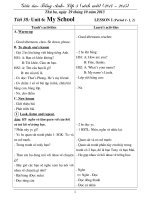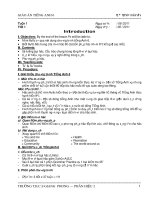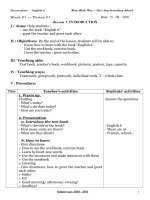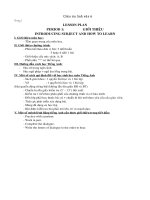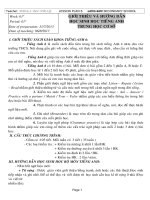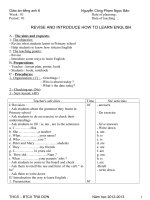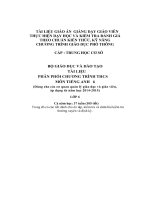Giáo án tiếng anh lớp 6 sách kết nối tri thức học kì 1
Bạn đang xem bản rút gọn của tài liệu. Xem và tải ngay bản đầy đủ của tài liệu tại đây (6.11 MB, 571 trang )
UNIT 1: MY NEW SCHOOL
Lesson 1: Getting started – A special day
Lesson aim(s)
By the end of the lesson, students will be able to:
- have an overview about the topic My new school;
- use the vocabulary to talk about school things.
Language analysis
Form
Meaning
Pronunciation
1. subject (n)
the thing that is being studied
/ˈsʌbdʒekt/
2. uniform (n)
a set of clothes that has to be worn by
the members of the same group of
people
/ˈjuːnɪfɔːm/
3. calculator (n)
an electronic device used for
mathematical processes
/ˈkælkjəleɪtər/
Materials (referenced)
-
Grade 6 textbook, Unit 1, Getting started
Projector/ pictures and cards
sachmem.vn
Anticipated difficulties
Solutions
Students may lack experience of
group/ team work.
-
-
1
Encourage students to work
in groups so that they can
help each other.
Give short, clear instructions
and help if necessary.
Board Plan
Date of teaching
Unit 1: My new school
Lesson 1: Getting started
* Warm-up
Memorising game
I. Vocabulary
1. subject (n)
2. uniform (n)
3. calculator (n)
II. Practice
Task 1: Listen and read.
Task 2: Read the conversation again and tick (✔) T (True) or F (False).
Task 3: Write one word from the box in each gap.
Task 4: Match the words with the school things. Then listen and repeat.
Task 5: Write names of the things you can see around the class in your
notebook.
* Homework
Stage
Warm-up
Stage aim
Procedure
Interaction Time
- To activate
* Memorising game:
Team work 5
students’
- Teacher
mins
knowledge on
divides class
the topic of
into 2
the unit.
teams.
- To set the
- Teacher asks
context for
students to
the listening
close the
and reading
books,
part.
shows the
picture
(pages 6
and 7) and
asks them to
memorise
2
every detail
in the
picture in 1
minute.
- Teacher
hides the
pictures and
asks
questions
about the
picture. The
team who
has more
correct
answers is
the winner.
1. How many people can
you see in the picture?
2. Who are they?
3. Where are they?
4. What are the two
students carrying on
their backs?
5. Where are they going to
go?
Suggested answers:
1. I can see three people.
2. They are students.
3. They are at one of the
boys’ home.
4. They are carrying school
bags/ backpacks.
5. They are going to go to
school.
- Teacher sets
the context
for the
listening and
3
reading text:
Write the
title on the
board A
special day.
Explain the
meaning of
special and
ask students
to guess
what the
conversation
might be
about.
Presentation To prepare
(Vocab –
students with
pre-teach) vocabulary.
Practice
-
VOCABULARY
Teacher introduces the
vocabulary by:
- giving
explanations
;
- showing the
pictures
illustrating
the words.
1. subjects (n)
[explanations]
2. uniform (n) [picture]
3. calculator (n) [picture]
T Task 1: Listen and read.
o
- Teacher
h
plays the
a
recording
v
twice.
e
- Students
s
listen and
t
read.
4
T-Ss
5
mins
T-Ss
5
mins
u
d
e
n
t
s
k
n
o
w
t
h
e
t
o
p
i
c
.
-
T
o
h
a
v
e
s
t
u
d
e
n
-
-
Teacher
checks
students’
prediction.
Teacher calls
3 students
to read the
conversation
aloud.
Task 2: Read the
conversation again and
tick (✔) T (True) or F
(False).
- Teacher tells
students to
read the
conversation
again and
work
independent
ly to find the
answers.
Remind
students to
underline
the
information
and correct
the false
statements.
- Teacher has
students
pair
compare
before
checking
with the
5
7
mins
T-Ss
Ss-Ss
T-Ss
5
mins
S
t
s
g
e
t
s
p
e
c
i
fi
c
i
n
f
o
r
m
a
ti
o
n
o
f
t
h
e
t
e
x
t.
-
whole class.
Teacher calls
some
students to
give the
answers.
T-Ss
Ss-Ss
Answer key:
1. T
2. F
3. T
4. T
5. F
7
mins
Task 3: Write one word
from the box in each gap.
- Teacher has
students
read the
conversation
again, work
independent
ly to put a
suitable
word from
the box to
fill in the
gap.
- Teacher calls
one student
to share
his/her
answer on
the board.
- Teacher asks
students to
look at the
6
T-Ss
Ss-Ss
Answer key:
1. wear
2. has
3. go
4. uniforms
5. subjects
-
T
o
c
h
e
c
k
s
t
u
d
e
n
t
s
u
n
d
e
r
s
t
a
board, check
their mate’s
answer.
Task 4: Match the words
with the school things.
Then listen and repeat.
*Pelmanism
- Teacher
divides the
class into 2
teams.
- Teacher put
two sets of
cards, one
includes
pictures of
school
things and
the other
includes
their names.
Members
from two
teams take
turns and
matchs the
names with
the correct
pictures as
fast as
possible.
7
Group
work
6
mins
n
The team
d
matched
i
faster and
n
correctly is
g
the winner.
o
f
t
h
e
c
o
n
v
e
r
s Task 5: Write names of the
a things you can see around
ti the class in your notebook.
- Students
o
work in
n
groups of
a
four to look
n
around the
d
class and
h
write down
e
things they
l
can see in
p
the class.
s
- Students
t
may ask
u
teacher if
d
they don’t
e
know the
n
names of
t
the items.
s
- Students
u
share with
s
8
e
t
h
e
w
o
r
d
s
i
n
c
o
n
t
e
x
t.
the whole
class.
- To provide
students
vocabulary.
9
-
T
o
c
h
e
c
k
s
t
u
d
e
n
t
s’
v
10
o
c
a
b
u
l
a
r
y
a
n
d
i
m
p
r
o
v
e
g
r
o
u
p
w
o
r
k
s
k
il
l.
Consolidation To consolidate
what students
have learnt in
the lesson.
Teacher asks students to
talk about what they have
learnt in the lesson.
11
T-Ss
3
mins
Homework
To review the
lesson and
prepare for the
next lesson.
-
12
Do exercises
in the
workbook.
Think of
activities
students can
do at school.
T-Ss
2
mins
UNIT 1: MY NEW SCHOOL
Lesson 2: A closer look 1
Lesson aim(s)
By the end of the lesson, students will be able to:
- use the lexical items related to the topic My new school;
- use the combinations: to study, to have, to do, to play + N;
- pronounce correctly the sounds /ɑː/ and /ʌ/.
Language analysis
Form
Meaning
Pronunciation
1. science (n)
a particular subject that is studied
using scientific methods.
2. exercise (n/v)
physical activity that you do to make
your body strong and healthy.
/ˈsaɪəns/
/ˈeksəsaɪz/
Materials (referenced)
-
Grade 6 textbook, Unit 1, A closer look 1
Projector/ Pictures
sachmem.vn
Anticipated difficulties
1. Students may have difficulties
in distinguishing two sounds
/ɑː/ and /ʌ/.
Solutions
Provide students some tips by identifying
the letters may include each sound.
2. Some students will excessively
talk in the class.
-
13
Define expectation in explicit
detail.
Have excessive talking
students practise.
Continue to define
expectations in small chunks
(before every activity).
Board Plan
Date of teaching
Unit 1: My new school
Lesson 2: A closer look 1
* Warm-up
Game: Hot seat
I. Vocabulary
1. science (n)
2. exercise (n/v)
Task 1: Listen and repeat the words.
Task 2: Put the words in the correct columns.
Task 3: Put the words in the blanks.
II. Pronunciation
Task 4: Listen and repeat. Pay attention to the sounds /ɑː/ and /ʌ/.
Task 5: Listen and repeat. Underline the words with the sounds /ɑː/ and /ʌ/.
III. Production
Game: Who is faster?
* Homework
Stage
Stage aim
Procedure
Warm-up
To activate
students’ prior
knowledge and
vocabulary
related to the
topic.
* Game: Hot seat
- Teacher
divides
students
into 2
teams.
Each team has a member
standing against the
board.
- Teacher
shows
pictures of
some
14
Interaction Time
Team work
5
mins
-
activities
one by
one and
other
members
use body
language
to let their
team
member
guess the
names of
the
activities.
The team
with the
most
correct
answers in
the fastest
time is the
winner.
Answer key:
play football
15
listen to music
skip rope
drink water
watch TV
16
play video games
Presentation To enrich
(Vocab –
students’
pre-teach) vocabulary.
Practice
To teach
students some
activities they
can do at
school.
To help student
identify which
nouns go after
which verbs to
make names of
school activities.
VOCABULARY
- Teacher
introduces
the
vocabulary
by:
+ providing explanations
of the words;
+ showing picture
illustrating the word.
1. science (n) [picture]
2. exercise (n/v)
[explanation]
T-Ss
3
mins
Task 1: Listen and repeat
the words.
- Teacher
asks
students
to listen
and repeat
the words.
- Teacher
calls some
students
to read the
words
aloud.
T-Ss
16
mins
17
Pair work
Task 2: Work in pairs. Put
the words in Task 1 in
the correct columns.
- Teacher
asks
students
to work in
pairs and
use the
words in
Task 1 to
put into
the correct
columns.
- Students
work in
pairs and
do the
task.
- Teacher
calls some
pairs to
share their
answers
with the
whole
class.
- Teacher
gives
To help students
feedback
use the
and
vocabulary in
correction
context.
s (if
necessary)
.
Answer key:
play
18
do
T-Ss
S
Ss-Ss
football
music
homework
exercise
have
school lunch
lessons
study
English
history
science
-
-
Teacher
explains
which
nouns go
with each
verb to
make
meaningfu
l names of
activities.
Teacher
asks
students
to work in
groups of
four and
add as
many
words into
each
column as
possible.
Task 3: Put the words in
the blanks.
- Teacher
asks
students
to work
independe
ntly and
put a
19
T-Ss
-
-
Answer key:
1. homework
2. football
3. lessons
4. exercise
5. science
Presentation
(Pre-teach
the sounds
/ɑː/ and /ʌ/)
suitable
word in
each
blank.
Teacher
allows
students
to share
their
answers
before
discussing
as a class.
Teacher
asks some
students
to share
the
answers
and gives
feedback.
To help students PRONUNCIATION
have concept
- Teacher
and identify the
introduces
sounds /ɑː/
2 sounds
and /ʌ/.
/ɑː/ and
/ʌ/ to
students
and lets
them
watch a
20
T- Ss
5
mins
video
about how
to
pronounce
these two
sounds.
/watch?v=1F47WdIjn5U
/watch?v=zUpF0pYoTZ8
- Teacher
asks
students
to give
some
words they
know
containing
these
sounds.
Suggested answers:
- /ɑː/: car,
start, after,
party
- /ʌ/: cut,
one,
country
- Teacher
draws
students
attention
to the
letters
containing
the sounds
and helps
them
identify
21
the
sounds.
Practice
To help students Task 4: Listen and repeat.
identify and
Pay attention to the
practise the /ɑː/ sounds /ɑː/ and /ʌ/.
and /ʌ/ sounds.
- Teacher
asks
students
to listen
and
To help students
repeat.
practise the
- Students
sounds /ɑː/
work
and /ʌ/ in
independe
sentences.
ntly.
Task 5: Listen and repeat.
Underline the words
with the sounds /ɑː/ and
/ʌ/.
- Before
listening,
teacher let
students
discuss in
pairs and
find the
words with
the sounds
/ɑː/ and
/ʌ/.
- Teacher
plays the
recording
for
students
22
T-Ss
Pair work
T- Ss
6
mins
to check
and repeat
the
sentences.
Production
To give students * Game: Who is faster?
a chance to
- Teacher
apply what they
divides
have learnt.
students
into
groups of
four, gives
each
group a
piece of
paper, asks
them to
write
sentences
including 2
features:
school
activities
and one of
the sounds
/ɑː/ or /ʌ/.
- (e.g: I
usually
play
basketball
with my
brother.)
- Teacher
asks each
group to
hand in
their
23
Group
work
5
mins
-
Consolidation To consolidate
what students
have learnt in
the lesson.
Homework
paper and
checks,
the group
with more
correct
sentences
is the
winner.
Teacher
invites the
winner to
read aloud
their
sentences.
Teacher asks students to
talk about what they
have learnt in the lesson.
T-Ss
3
mins
Rewrite
the
sentences
into
notebooks
.
Find 3
more
school
activities
that have
the sound
/ɑː/ or /ʌ/.
T-Ss
2
mins
To revise what
they have
learnt.
-
-
24
UNIT 1: MY NEW SCHOOL
Lesson 3: A closer look 2
The present simple
Lesson aim(s)
By the end of the lesson, students will be able to use the present simple tense.
Language analysis
Form
Example
S + Vinf/ V(s/es) + … .
I usually go to school by bike.
S + don’t/ doesn’t + Vinf + … .
She doesn’t like school lunch very much.
Do/ Does + S + Vinf + … ?
Do they live near here?
W/H + do/does + S + Vinf + … ?
What do you often do after school?
Materials (referenced)
-
Grade 6 textbook, Unit 1, A closer look 2
Projector/Pictures, sets of word cards
sachmem.vn
Anticipated difficulties
1. Students may find confused
when to use the present simple
tense.
Solutions
Give short and clear explanations with
legible examples for each case.
2. Students may have
underdeveloped speaking and
co-operating skills.
-
-
25
Give clear instructions, give
examples before letting
students work in groups.
Provide feedback and help
if necessary.

